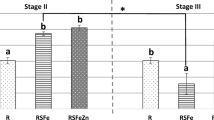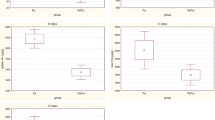Abstract
Two experiments were conducted using completely randomized designs to study the bioavailability of Si from three sources to growing rats and turkeys fed semipurified diets. The basal diets were dextrose-egg albumin for rats and dextrose-casein for turkeys. The Si sources were tetraethylorthosilicate (TES), sodium silicate (NaSil), and sodium zeolite A (NaZA). Rats and turkeys were supplemented at 500 and 270 ppm Si, respectively, from each source. A control group of unsupplemented rats and turkeys was included in each experiment. In general, irrespective of Si source, Si supplementation slowed (p < 0.05 orp < 0.01) growth rates in both rats and turkeys. Although dietary Si supplementation reduced (p < 0.05) plasma Mg levels and liver Zn concentrations in rats, it increased (p < 0.05) plasma P and reduced (p < 0.05) plasma Cu levels in turkeys. Rats on TES had significantly slower (p < 0.05 orp < 0.01) growth rates (5–10%) than those on NaSil or NaZA. In rats, NaZA and TES reduced (p < 0.05) hemoglobin concentrations and plasma Zn, respectively. However, plasma Mg levels were higher (p < 0.05) in TES than NaSil-or NaZA-fed rats. The source of the dietary Si did not affect (p < 0.05) the organ weights of rats and their mineral concentrations. Turkeys on TES diets grew at a significantly faster (p < 0.05) rate (15%) than those on NaSil or NaZA diets during the first 2 wk of experimentation. However, after 4 wk, there were no significant (p > 0.05) differences in growth between the Si sources. In turkeys, NaZA increased (p < 0.05) hematocrit levels and plasma Mg levels. Turkeys on NaZA diets had larger (p < 0.05) hearts and livers than those on NaSil but not TES. Liver Mn content was higher (p < 0.05) in turkeys on NaSil than TES or NaZA. Heart Zn was lower (p < 0.05) in turkeys on NaSil than TES, but not NaZA.
Similar content being viewed by others
References
R. K. Iler,The Chemistry of Silica, Wiley, New York, (1979).
C. D. Seaborn and F. H. Nielsen,Nutr. Today 28, 13–18 (1993).
E. M. Carlisle, Silicon inTrace Elements in Man and Animal Nutrition, Vol. 2, 5th ed., W. Mertz, ed., Academic, New York, pp. 373–390 (1986).
E. M. Carlisle,Ciiba Found. Symp. 121, 123–139 (1986).
E. M. Carlisle,Science 178, 619–621(1972).
R. J. Emerick,Nutr. Rep. Int. 34, 907–913 (1986).
R. J. Emerick,J. Nutr. 117, 1924–1928 (1987).
J. Najda, J. Gminski, M. Drozdz, and A. Danch,Biol. Trace Element Res. 37, 107–114 (1993).
K. Schwarz and D. B. Milne,Nature 239, 333–334 (1972).
K. E. Wiegand,Poultry Sci,70, (Suppl.1), 131 (1991).
J. D. Birchall, Silicon and the bioavailability of aluminum—nutritional aspects, inFood, Nutrition and Chemical Toxicity, D. V. Parke, C. Ioannides, and R. Walker, eds., Smith-Gordon, Great Britain, pp. 215–226 (1993).
T. P. A. Kruch and D. R. Mclachlan, Mechanisms of aluminum neurotoxity relevance to human diseases, inMetal Ions in Biological Systems, Vol. 24, H. Sigel and A. Sigel eds., Marcel Dekker, New York(1988).
R. J. Emerick, and H. Kayongo-Male,J. Nutr. Biochem. 1, 35–40 (1990).
National Research Council,Nutrient Requirements of Poultry, 9th ed., National Academy Press, Washington, DC (1994).
S. R. Stewart, R. J. Emerick, and H. Kayongo-Male,J. Anim. Sci. 71, 946–954 (1993).
B. L. Oser,Hawk’s Physiological Chemistry, 14th ed., McGraw-Hill, New York (1965).
SAS,SAS Procedures Guide (Release 6.03 Ed.), SAS Institute Inc., Cary, NC (1988).
R. G. D. Steel and J. H. Torrie,Principles and Procedures of Statistics:A Biomedical Approach, 2nd ed., McGraw-Hill, New York (1980).
A. C. Alfrey, Aluminum, inTrace Elements in Human and Animal Nutrition, Vol. 2, 5th ed., W. Mertz, ed., Academic, New York, pp. 399–413 (1986).
L. M. Klevy,Ann. NY Acad. Sci. 355, 140–151 (1980).
L. M. Klevy,Clin. Geriatr. Med. 3, 361–372 (1987).
L. S. Hurley, and C. L. Keen, Manganese, inTrace Elements in Human and Animal Nutrition, Vol. 1, 5th ed., W. Mertz, ed., Academic, New York, Vol. 1, pp. 185–224 (1987).
Author information
Authors and Affiliations
Rights and permissions
About this article
Cite this article
Kayongo-Male, H., Jia, X. Silicon bioavailability studies in young rapidly growing rats and turkeys fed semipurified diets. Biol Trace Elem Res 67, 173–186 (1999). https://doi.org/10.1007/BF02784072
Received:
Revised:
Accepted:
Issue Date:
DOI: https://doi.org/10.1007/BF02784072




